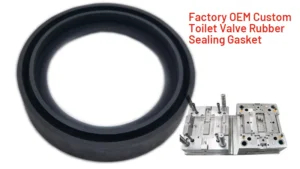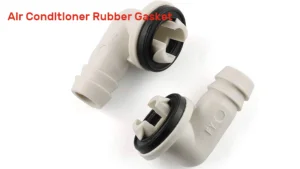Toilet valve rubber sealing gaskets are important components in plumbing systems. They typically last between 5 to 10 years on average, depending on different factors. The rubber sealing gaskets play a critical role in ensuring the proper functionality and efficiency of toilets. This post will introduce the toilet water valve rubber sealing gasket functions, materials, and structure.
The Role and Functions of Toilet Valve Rubber Sealing Gaskets
Toilet valve rubber sealing gaskets are responsible for creating a watertight seal between the toilet tank and the toilet bowl, preventing water leaks, and maintaining the integrity of the plumbing system. Here are the key functions of toilet valve rubber sealing gaskets:
Preventing Leaks
The primary function of a toilet valve rubber sealing gasket is to prevent water leaks. By forming a tight seal between the tank and bowl, the gasket ensures that water remains contained within the toilet system, avoiding any escape that could lead to water damage, mold growth, or costly repairs.
Maintaining Hygiene
A properly sealed toilet prevents foul odors and bacteria from escaping into the bathroom environment. The rubber sealing gasket plays a vital role in maintaining a clean and hygienic bathroom by containing any unpleasant smells or contaminants within the toilet system.
Ensuring Proper Flushing
Without a secure seal, the toilet may experience inefficiencies in flushing or even a complete failure to flush. The rubber sealing gasket helps maintain the proper pressure and water flow within the toilet system, ensuring efficient and reliable flushing.
Preventing Wobbling
A faulty or improperly installed gasket can cause the toilet to wobble or shift, leading to further leaks and potential damage. The rubber sealing gasket helps stabilize the toilet, preventing any unwanted movement or shifting during use.
Durability and Longevity
Toilet valve rubber sealing gaskets are designed to withstand the harsh conditions of a bathroom environment, including exposure to water, chemicals, and temperature fluctuations. High-quality rubber gaskets can last for years, providing reliable performance and minimizing the need for frequent replacements.
Structure of the Toilet Valve Rubber Sealing Gasket
The toilet valve rubber sealing gasket is generally made of rubber or other elastic materials. Its structure can be divided into two parts: one is the fixed part, which is used to connect the bottom of the water tank and the drainage pipe;
The other is the movable part, which is used to seal the water inside the water tank. The movable part is usually conical and can automatically adjust the sealing state as the water level in the water tank changes.
Toilet Valve Rubber Sealing Gaskets Materials and Characteristics
Toilet valve rubber sealing gaskets materials can be divided into rubber, silicone, plastic, and other types according to different materials. Among them, the rubber pad made of rubber is the most common material. The toilet valve rubber sealing gaskets material must have the following characteristics:
Water Resistance
The sealing gasket will be in constant contact with water, so the material must have excellent water resistance and should not deform or degrade when exposed to moisture.
Chemical Resistance
Toilet cleaning agents often contain various chemicals. Therefore, the material of the gasket needs to be resistant to these chemicals to prevent corrosion or damage over time.
Temperature Resistance
The gasket must withstand a wide range of temperatures, from cold to hot, without losing its integrity. The material should have a broad operating temperature range to ensure functionality.
Aging Resistance
Over time, gaskets can be affected by oxidation and other environmental factors. The material should have good aging resistance to maintain sealing performance over the long term.
Elasticity
The gasket needs to be able to deform during installation to fit various spaces while maintaining elasticity during use to ensure a lasting seal.
Wear Resistance
The gasket will experience repeated pressure and friction during its lifespan, so the material should have good wear resistance to ensure longevity.
How to Design a Custom Toilet Valve Rubber Sealing Gasket?
1.Identify Specifications: Determine the specific requirements for the gasket, including dimensions, shape, and material preferences based on the toilet model and its installation environment.
2.Upload Design Information: Submit the specifications, including drawings or measurements, and any additional requirements such as temperature or chemical resistance.
3.Offer Sample Test: We produced and sent samples to ensure the product meets your requirements.
4.Place the Order: Order the custom gaskets once satisfied with the design and fit. Ensure to discuss lead times and delivery options.
How to Replace a Toilet Valve Rubber Sealing Gasket?
1.Disconnect the Water Supply Line: Use an adjustable wrench to disconnect the water supply line from the bottom of the toilet tank.
2.Remove the Tank Lid: Carefully lift off the lid and set it aside in a safe place.
3.Remove the Old Sealing Gasket: Locate the flush valve assembly inside the tank. Remove the nuts or screws that hold the flush valve in place. Remove the old gasket from the bottom of the flush valve.
4.Clean the Area: Wipe down the area where the gasket was seated to remove any residue, grime, or mineral deposits. This will ensure a proper seal when the new gasket is installed.
5.Install the New Gasket: Place the new rubber sealing gasket onto the flush valve. Reattach the flush valve assembly, securing it back into place with nuts or screws.
Conclusion
Rubber sealing gaskets play a vital role in the functionality and efficiency of toilet systems. They are essential components that prevent leaks, maintain hygiene, and ensure proper flushing. The durability and reliability of these gaskets are crucial for avoiding costly repairs and water damage, making them indispensable in toilet repair and maintenance. If you encounter unique toilet models or specific requirements that standard gaskets cannot meet, welcome to contact us to order customized toilet valve rubber sealing gaskets.






